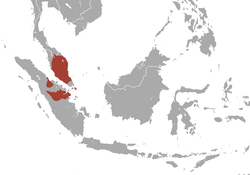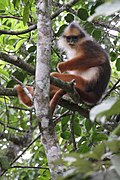Presbytis
Genus of south-east Asian monkeys From Wikipedia, the free encyclopedia
Presbytis is a genus of Old World monkeys also known as langurs, leaf monkeys, or surilis. Members of the genus live in the Thai-Malay Peninsula, on Sumatra, Borneo, Java and smaller nearby islands.[1]
| Presbytis | |
|---|---|
 | |
| Javan surili | |
| Scientific classification | |
| Domain: | Eukaryota |
| Kingdom: | Animalia |
| Phylum: | Chordata |
| Class: | Mammalia |
| Order: | Primates |
| Suborder: | Haplorhini |
| Infraorder: | Simiiformes |
| Family: | Cercopithecidae |
| Subfamily: | Colobinae |
| Tribe: | Presbytini |
| Genus: | Presbytis Eschscholtz, 1821 |
| Type species | |
| Presbytis mitrata | |
| Species | |
|
11, see text | |
Description
Surilis are rather small, slimly built primates. Their fur at the top is brown, grey, black, or orange, and at the lower surface whitish or greyish, sometimes also orange, with some species having fur designs at the head or at the hips.[2][3] Their German name of Mützenlanguren ("capped langurs") comes from the hair on their head, which forms a tuft. They differ from the other langurs by characteristics in the shape of their head (particularly the poorly developed or absent brow ridges, and the prominent nasal bones),[2] in the teeth, and by the size of their small thumbs. Surilis range in adult length from 40 to 60 cm (with a 50- to 85-cm-long tail) and a weight of 5 to 8 kg.[2]
Behaviour
Diurnal forest dwellers, they spend nearly their entire lives in the trees. They live in groups of up to 21 animals (typically 10 or fewer animals in most species) consisting of a male, several females, and their young.[3] A few species have been observed in monogamous pairings (particularly the Mentawai langur),[3] although this might be a reaction to the decrease of their habitat. Lone males and all-male groups have also been reported.[2] The groups are hierarchically developed, with intergroup communication that is both vocal and postural.
Diet
The surilis' diet consists of leaves, fruits, and seeds.[3]
Breeding
Gestation time is 5–6 months, and births are typically of single young. Newborn animals are white colored and have a black strip at the back, although some have a cross-shaped mark. By one year old, the young are weaned and at an age of 4–5 years, they are fully mature. The typical life expectancy in the wild remains poorly known for most species, but captive Sumatran surilis have lived more than 18 years.[2]
Conservation
Several species in this genus are restricted to regions with extensive habitat destruction, and are also threatened by hunting. Consequently, 16 of the 19 species are rated as vulnerable or worse by IUCN,[4] and the Sarawak surili has been referred to as "one of the rarest primates in the world."[5] Recently, a subspecies of Hose's langur called Miller's grizzled langur, thought to be extinct, was rediscovered in the Wehea Forest on the eastern tip of Borneo island,[6] though it remains one of the world's most endangered primates.[7]
Taxonomy
Summarize
Perspective
Two other genera, Trachypithecus and Semnopithecus, were formerly considered subgenera of Presbytis.[1] The species-level taxonomy of Presbytis is complex, and significant changes have been proposed for several in recent years.[1][8][9][10]
| Common name | Scientific name and subspecies | Range | Size and ecology | IUCN status and estimated population |
|---|---|---|---|---|
| Black Sumatran langur
|
P. sumatrana (S. Müller & Schlegel, 1841) |
Island of Sumatra in Indonesia | Size: 42–61 cm (17–24 in) long, plus 50–85 cm (20–33 in) tail[11] Habitat: Forest[12] Diet: Fruit, leaves, seeds and flowers[12] |
EN
|
| Black-and-white langur
|
P. bicolor Aimi & Bakar, 1992 |
Island of Sumatra | Size: 42–61 cm (17–24 in) long, plus 50–85 cm (20–33 in) tail[11] Habitat: Forest[13] Diet: Fruit, seeds, and leaves[11] |
DD
|
| Black-crested Sumatran langur | P. melalophos (Raffles, 1821) |
Island of Sumatra |
Size: 42–61 cm (17–24 in) long, plus 50–85 cm (20–33 in) tail[11] Habitat: Forest and shrubland[14] Diet: Fruits and leaves, as well as seeds and flowers[15] |
EN
|
| East Sumatran banded langur
|
P. percura Lyon, 1908 |
Island of Sumatra | Size: 42–61 cm (17–24 in) long, plus 50–85 cm (20–33 in) tail[11] Habitat: Forest[16] Diet: Fruit, seeds, and leaves[11] |
CR
|
| Hose's langur | P. hosei (Thomas, 1889) |
Borneo |
Size: 42–61 cm (17–24 in) long, plus 50–85 cm (20–33 in) tail[11] Habitat: Forest[17] Diet: Leaves, unripe fruits, seeds, flowers, bird eggs and nestlings[17] |
VU
|
| Javan surili | P. comata (Desmarest, 1822) Two subspecies
|
Island of Java in Indonesia |
Size: 42–61 cm (17–24 in) long, plus 50–85 cm (20–33 in) tail[11] Habitat: Forest[18] Diet: Leaves, as well as fruits, flowers, and seeds[18] |
VU
|
| Maroon leaf monkey | P. rubicunda (S. Müller, 1838) Five subspecies
|
Borneo |
Size: 42–61 cm (17–24 in) long, plus 50–85 cm (20–33 in) tail[11] Habitat: Forest and inland wetlands[19] Diet: Leaves, seeds, and fruit, as well as flowers and pith[19] |
VU
|
| Siberut langur | P. siberu (Chasen & Kloss, 1928) |
Island of Siberut in Indonesia |
Size: 42–61 cm (17–24 in) long, plus 50–85 cm (20–33 in) tail[11] Habitat: Forest[20] Diet: Fruit, seeds, and leaves[11] |
EN
|
| Mentawai langur
|
P. potenziani (Bonaparte, 1856) |
Mentawai islands in Indonesia |
Size: 42–61 cm (17–24 in) long, plus 50–85 cm (20–33 in) tail[11] Habitat: Forest[21] Diet: Fruit, seeds, and leaves[11] |
CR
|
| Miller's langur | P. canicrus G. S. Miller, 1934 |
Eastern Borneo (in light green) |
Size: 42–61 cm (17–24 in) long, plus 50–85 cm (20–33 in) tail[11] Habitat: Forest[22] Diet: Fruit, seeds, and leaves[11] |
EN
|
| Mitered langur | P. mitrata Eschscholtz, 1821 |
Island of Sumatra | Size: 42–61 cm (17–24 in) long, plus 50–85 cm (20–33 in) tail[11] Habitat: Forest[23] Diet: Fruit, seeds, and leaves[11] |
VU
|
| Natuna Island surili
|
P. natunae (Thomas & Hartert, 1894) |
Island of Natuna Besar in Indonesia |
Size: 42–61 cm (17–24 in) long, plus 50–85 cm (20–33 in) tail[11] Habitat: Forest[24] Diet: Fruit, seeds, and leaves[11] |
VU
|
| Raffles' banded langur | P. femoralis (Martin, 1838) |
Singapore and southern Peninsular Malaysia |
Size: 42–61 cm (17–24 in) long, plus 50–85 cm (20–33 in) tail[11] Habitat: Forest[25] Diet: Fruit, seeds, and leaves[11] |
CR
|
| Robinson's banded langur | P. robinsoni Thomas, 1910 |
Southern Malay Peninsula |
Size: 42–61 cm (17–24 in) long, plus 50–85 cm (20–33 in) tail[11] Habitat: Forest[26] Diet: Fruit, seeds, and leaves[11] |
NT
|
| Sabah grizzled langur
|
P. sabana (Thomas, 1893) |
Eastern Borneo (in dark brown) |
Size: 42–61 cm (17–24 in) long, plus 50–85 cm (20–33 in) tail[11] Habitat: Forest[27] Diet: Fruit, seeds, and leaves[11] |
EN
|
| Sarawak surili | P. chrysomelas (S. Müller, 1838) Two subspecies
|
Northern Borneo |
Size: 42–61 cm (17–24 in) long, plus 50–85 cm (20–33 in) tail[11] Habitat: Forest[5] Diet: Fruit, seeds, and leaves[11] |
CR
|
| Thomas's langur | P. thomasi (Collett , 1893) |
Northern island of Sumatra in Indonesia |
Size: 42–62 cm (17–24 in) long, plus 50–85 cm (20–33 in) tail[28] Habitat: Forest[29] Diet: Fruit, leaves, and seeds, as well as flowers, bark, twigs, stalks, birds, bird eggs, algae, and insects[28] |
VU
|
| White-fronted surili | P. frontata (S. Müller, 1838) |
Borneo |
Size: 42–61 cm (17–24 in) long, plus 50–85 cm (20–33 in) tail[11] Habitat: Forest[30] Diet: Fruit, seeds, and leaves[11] |
VU
|
| White-thighed surili | P. siamensis (S. Müller & Schlegel, 1838) Four subspecies
|
Southeastern Asia |
Size: 42–61 cm (17–24 in) long, plus 50–85 cm (20–33 in) tail[11] Habitat: Forest[31] Diet: Fruit, seeds, and leaves[11] |
NT
|
References
Sources
External links
Wikiwand - on
Seamless Wikipedia browsing. On steroids.












